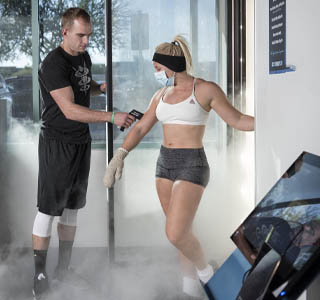How Cryotherapy is Changing the Way You Recover
Elite and professional athletes have taken to freezing themselves to speed up their post-training recovery and heal their injuries for a while. However, this cold recovery, cryotherapy, is now more easily accessed by the public, allowing anyone from casual exercisers with post-exercise soreness to those suffering from chronic ailments to find relief from their pain. But what is cryotherapy, exactly? Is there any research that can prove it speeds recovery and decreases muscle soreness?
What is cryotherapy?
Cryotherapy is a treatment that uses sub-zero temperatures to treat pain and injuries. It comes in many forms, whether that be entering a whole-body chamber or localizing the cold treatment on a certain part of your body. It is a more comfortable and quicker alternative to traditional ice baths. Athletes like the Minnesota Vikings, Floyd Mayweather, Lebron James, and Usain Bolt all swear by the effects cryotherapy has on their recovery time.
But why do athletes, specifically, use cryotherapy?
Any athlete or person who exercises is exceptionally prone to soreness and exercise-related injuries. Cryotherapy is able to help soreness and injuries in multiple ways.
The majority of us have experienced delayed onset muscle soreness (DOMS) 24 to 48 hours after a particularly brutal workout or after your first gym session in a while. DOMS is a result of micro-tears in the muscle, repairing these micro-tears results in muscle hypertrophy (growth). While these tears are completely necessary, their side effects, like soreness, inflammation, pain, and discomfort, are less than welcome.
When entering the whole-body cryotherapy chamber, your body, to protect itself from the cold, regulates your blood flow to your core, where there are a lot of nutrients. After stepping out of the chamber, your body begins to warm up and distributes your blood, now filled with additional nutrients, to the rest of your body. Along with sending nutrient-rich blood to your extremities, the cold also helps decrease inflammation and pain in your joints and muscles.
Is it scientifically backed?
Luckily, this panacea of sorts has empirical evidence to back up its claims.
One study published on PubMed Central found that trained runners showed fewer blood markers of inflammation after entering the cryotherapy chamber. The study followed a group of trained runners and put them through a 48-minute trail run on a treadmill. The workout was specifically designed to elicit muscle soreness and damage.
After the workout, half of the runners underwent whole-body cryotherapy once a day for five days. The rest sat still for 30 minutes a day after their workout for those five days. Blood was drawn regularly throughout the experiment from both groups.
From the first day onward, the runners who entered the chamber showed fewer blood markers of inflammation than the group who sat still.
The study showed that by using the therapy, tired athletes could return to training sooner, said François Bieuzena, a professor at the National Institute of Sport, Expertise and Performance in Paris and lead author of the study.
Another study published in 2011 reviewed the effect of whole-body cryotherapy on recovery after exercise-induced muscle damage. Nine exceptional runners started by participating in a VO2 max test to measure their aerobic capacity. At a later date, on two separate occasions, the participants ran for 48 minutes on a treadmill using a protocol designed to produce delayed onset muscle soreness. After they finished running, they were randomly assigned one of two types of recovery. After one workout, they underwent three minutes of whole-body cryotherapy immediately post-exercise, 24 hours, and then 48 hours post-exercise. After the other workout, they sat for 30 minutes in a room set at a comfortable temperature. Researchers then measured muscle pain, tiredness, quadriceps strength, and collected blood samples. All variables were measured before the workout, immediately after, and at one, 24, and 48 hours post-exercise.
In reviewing their research, the study found that ratings of muscle pain and tiredness were reduced after the first whole-body cryotherapy session.
Would cryotherapy benefit me?
Cryotherapy can benefit just about everyone. Many athletes use cryotherapy to relieve their soreness or promote faster healing of their injuries. Those who suffer from chronic pain or inflammation use cryotherapy to reduce that pain and inflammation. People with mental illnesses or chronic migraines use both whole-body and localized cryotherapy to reduce symptoms. Those who suffer from skin conditions, such as eczema, use cryotherapy to reduce their symptoms. People who do not have any conditions may use cryotherapy for the energy boost and to feel rejuvenated.
However, certain conditions are contraindications to whole-body cryotherapy so speak to your doctor before partaking in cryotherapy.
Ok, where do I sign up?
Xperience Fitness has partnered with US Cryotherapy, the industry leader in whole-body cryotherapy. Through US Cryotherapy, Xperience offers four cryotherapy options.
- Whole-body cryotherapy: 2 to 3.5 minutes of full-body cold exposure that reduces pain, inflammation, and stress while rejuvenating your body, skin, and mind. Our whole-body cryotherapy chambers are nitrogen-free, free oxygenated air.
- Localized cryotherapy: Targets specific muscle areas or joints directly with cold air for 2 to 3 minutes to decrease pain and inflammation while improving circulation.
- Normatec: Uses compression therapy to increase circulation and moves fluid through the body to promote faster recovery.
- Theragun: An advanced massage device that breaks up muscle tightness, reduces soreness, and restores range of motion in as little as 30 seconds.
Visit your local club for more information regarding cryotherapy. Cold is a powerful energy, use it to get your life back today.
